Design and installation of antenna mast structures of the SV range
Not so long ago, in the open spaces of Habr, one could quite often meet posts dedicated to any design and installation works in a coherent topic. I have always been especially interested in working in “field conditions” for several reasons.
Firstly, many technical solutions in such conditions are born literally on the spot, giving food for the mind. Secondly, for me it is a close subject.
Recently, the number of such posts has decreased, I think. This was the impetus for me to write about the work of the office in which I am working. One of our directions is the construction of antenna-mast structures made of composite materials. For a more detailed description of all, albeit small, but the know-how of our office, I will make a report on the trip, which took place in the end of December to the village of Golubitskaya, to the Temryuk radio center. Our task was to install a 30-meter biconical antenna of the SV range.
In the mast design, it looks like this. Blue shows the conductors. In our case - 16 pieces.
')

The principal difference of this antenna for our company was that it was decided to use a new method of assembling the antenna. The mast itself, in the new version, consists of fiberglass nozzles and sleeves connecting them.
About sleeves should be told separately. For them, it was decided to use the material "prepreg" . In short, it is carbon fiber (or glass) with layers of epoxy resin. As semi-finished products from the factory, they come in the form of a roll and perfectly bend and cut like linoleum. Further, depending on the thickness of the fibers, setting the desired shape, you need to apply your heat treatment cycle. After that, the material hardens "to break" is not inferior to steel.
To form the sleeves we need, we built a thermal “cabinet” where, with the needed thermal cycle, we rotated the shaft with the desired prepreg thickness. The construction of the cabinet and the formation of sleeves also took a lot of time, but this is a completely different story.
This is the wardrobe itself:


Sleeves "drove" to the object. Red shell - acrylic film for UV protection.

Now proceed directly to the installation. Near the radio center there is an antenna field, where nests for delays and the warping itself have already been jammed in advance for the antenna. The red marked the place of the future mast.

We should also note the climatic features of the area. The radio center is located between the Black Sea and the estuary. From this almost always the strongest ascending air flows, which affects the design of any high-rise structures there.
The first day we were engaged in the formation of parts of the mast, glued sleeves to the nozzles. Separately, it is worth noting the top sleeve and the bottom, which were also "welded" on their own.
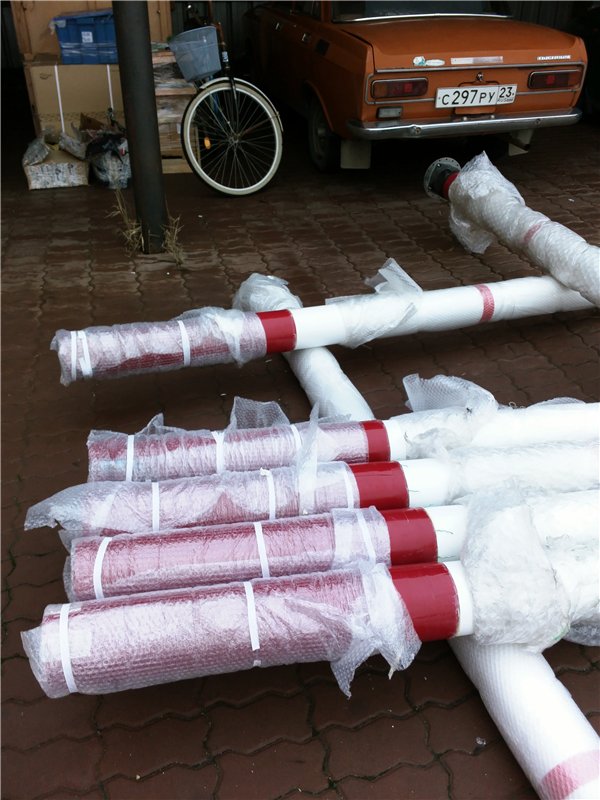
Top:
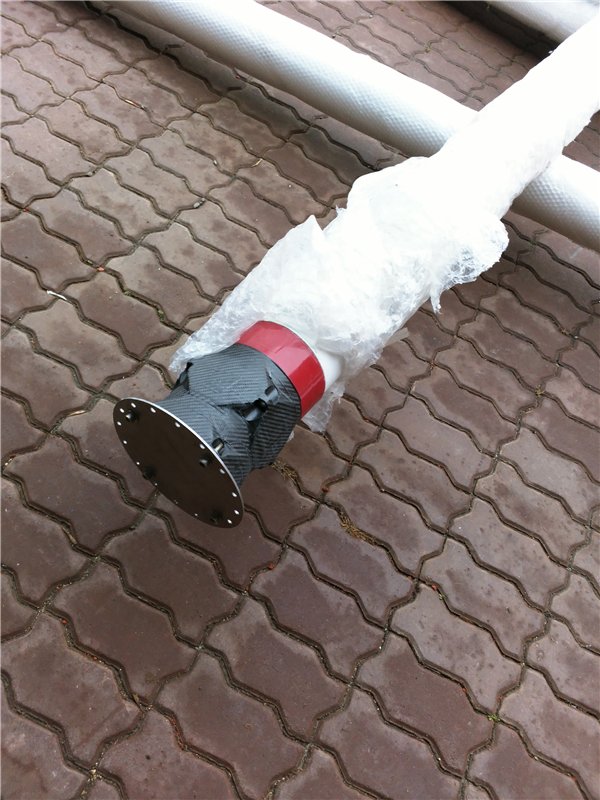
Bottom:

Since the work was carried out mostly in the field, the working day was limited to light day, no powerful illuminators were envisaged.
On the second day, the antenna parts migrated to the field. And the antenna was assembled on the ground:
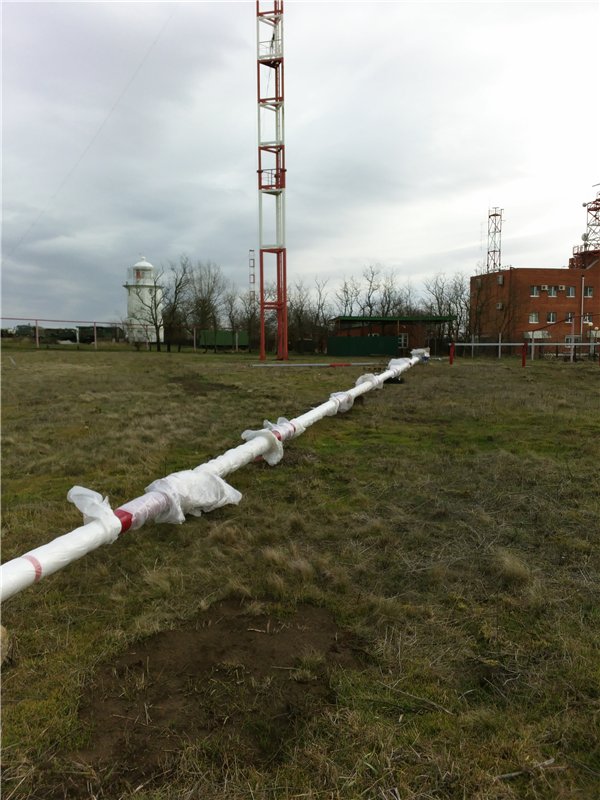
Next to the mast were attached a delay from the aramid rope, and conductors were attached to the conductive disks (see the photo of the top and bottom).
Then the fun began - the rise of the antenna.
The lifting itself is carried out with the help of a lever that we made of a fiberglass pipe:

But the difficulty lies in the perpendicular speed of the antenna plane and the plane of the lever, otherwise with a strong tension the mast arm may not withstand and crack. This problem is solved by constantly monitoring the tension of the guys during the whole climb.
It was already quite dark and it was impossible to work, it was necessary to postpone the final climb to the next day.
It was on such a sunny morning that the next day met us:

Right from the morning we began a gradual lifting of the mast. Some photos from this process:
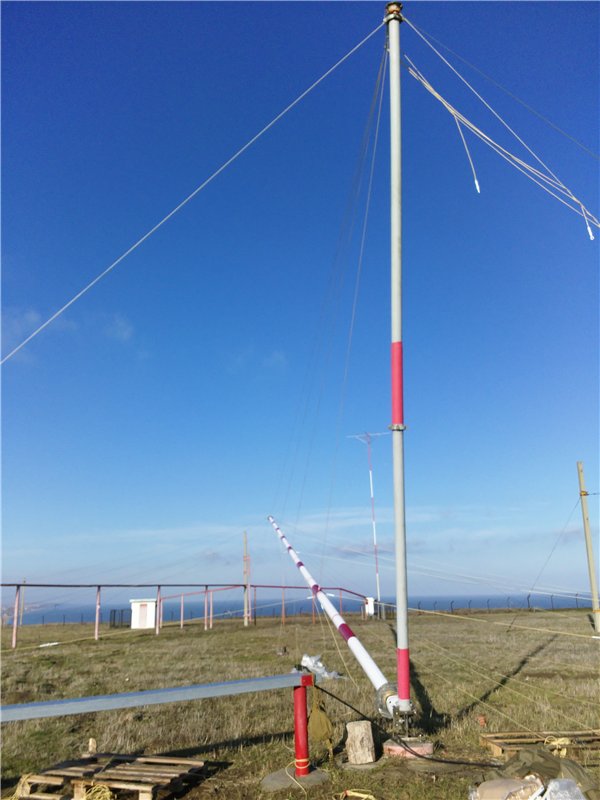
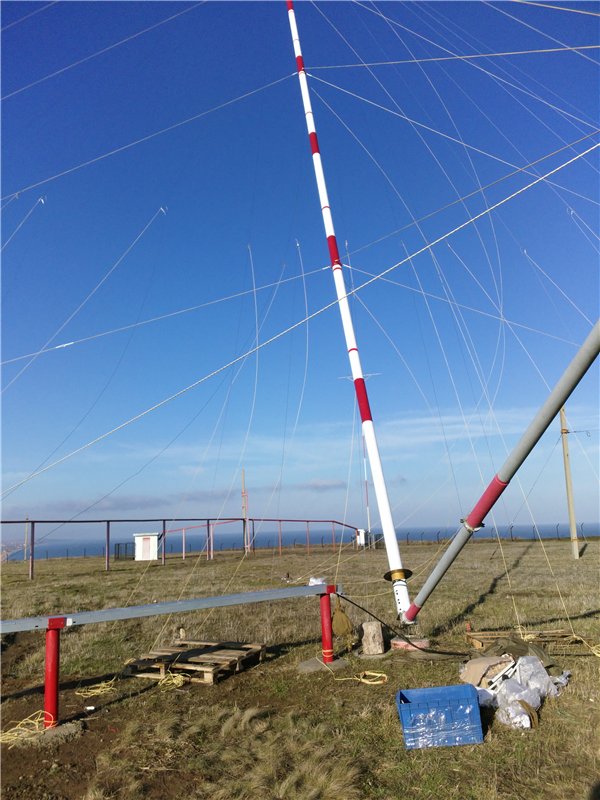

After lifting, it is important to set the vertical level and compensate for the tension of the ropes. Theodalite helps us to do this.
All the remaining time before dark we fix the conductors (we must also monitor the tension) to the lower conducting disk, from which the cable will already go to the radio center.

The fixing of the cable itself took place already in complete darkness with small flashlights in their hands, and there were no photos either.
Further, small debugging work and ... the antenna is working. They measured the CWS, asked the operator of another center to give a test account.
Unfortunately, due to the problems with the land conductors on the field, the antenna showed not the best performance. The CWS on our frequency is about 3, and the receiving bill is 2 - 3 out of 5. But the work to correct this problem will be carried out.
Thanks to everyone who read! I hope it was interesting.
Ready, finished antenna:
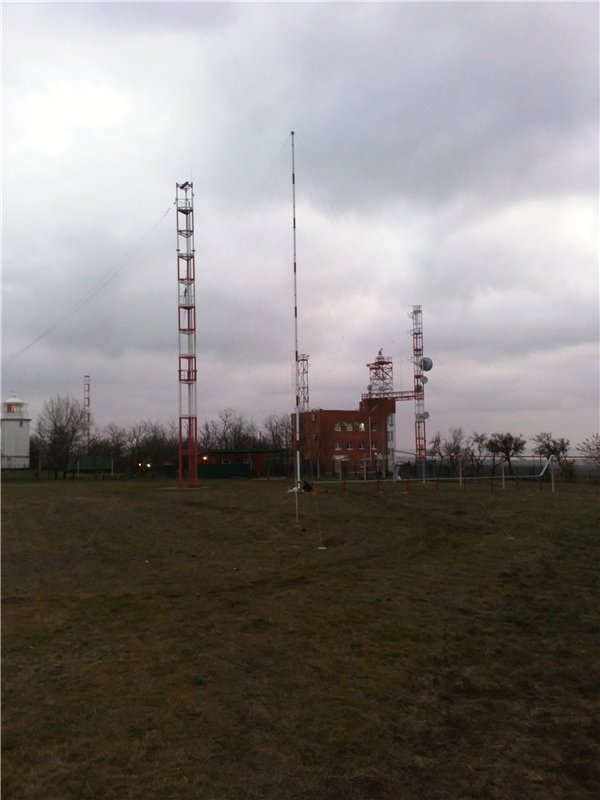
Firstly, many technical solutions in such conditions are born literally on the spot, giving food for the mind. Secondly, for me it is a close subject.
Recently, the number of such posts has decreased, I think. This was the impetus for me to write about the work of the office in which I am working. One of our directions is the construction of antenna-mast structures made of composite materials. For a more detailed description of all, albeit small, but the know-how of our office, I will make a report on the trip, which took place in the end of December to the village of Golubitskaya, to the Temryuk radio center. Our task was to install a 30-meter biconical antenna of the SV range.
In the mast design, it looks like this. Blue shows the conductors. In our case - 16 pieces.
')

The principal difference of this antenna for our company was that it was decided to use a new method of assembling the antenna. The mast itself, in the new version, consists of fiberglass nozzles and sleeves connecting them.
About sleeves should be told separately. For them, it was decided to use the material "prepreg" . In short, it is carbon fiber (or glass) with layers of epoxy resin. As semi-finished products from the factory, they come in the form of a roll and perfectly bend and cut like linoleum. Further, depending on the thickness of the fibers, setting the desired shape, you need to apply your heat treatment cycle. After that, the material hardens "to break" is not inferior to steel.
To form the sleeves we need, we built a thermal “cabinet” where, with the needed thermal cycle, we rotated the shaft with the desired prepreg thickness. The construction of the cabinet and the formation of sleeves also took a lot of time, but this is a completely different story.
This is the wardrobe itself:


Sleeves "drove" to the object. Red shell - acrylic film for UV protection.

Now proceed directly to the installation. Near the radio center there is an antenna field, where nests for delays and the warping itself have already been jammed in advance for the antenna. The red marked the place of the future mast.

We should also note the climatic features of the area. The radio center is located between the Black Sea and the estuary. From this almost always the strongest ascending air flows, which affects the design of any high-rise structures there.
The first day we were engaged in the formation of parts of the mast, glued sleeves to the nozzles. Separately, it is worth noting the top sleeve and the bottom, which were also "welded" on their own.

Top:

Bottom:

Since the work was carried out mostly in the field, the working day was limited to light day, no powerful illuminators were envisaged.
On the second day, the antenna parts migrated to the field. And the antenna was assembled on the ground:

Next to the mast were attached a delay from the aramid rope, and conductors were attached to the conductive disks (see the photo of the top and bottom).
Then the fun began - the rise of the antenna.
The lifting itself is carried out with the help of a lever that we made of a fiberglass pipe:

But the difficulty lies in the perpendicular speed of the antenna plane and the plane of the lever, otherwise with a strong tension the mast arm may not withstand and crack. This problem is solved by constantly monitoring the tension of the guys during the whole climb.
It was already quite dark and it was impossible to work, it was necessary to postpone the final climb to the next day.
It was on such a sunny morning that the next day met us:

Right from the morning we began a gradual lifting of the mast. Some photos from this process:



After lifting, it is important to set the vertical level and compensate for the tension of the ropes. Theodalite helps us to do this.
All the remaining time before dark we fix the conductors (we must also monitor the tension) to the lower conducting disk, from which the cable will already go to the radio center.

The fixing of the cable itself took place already in complete darkness with small flashlights in their hands, and there were no photos either.
Further, small debugging work and ... the antenna is working. They measured the CWS, asked the operator of another center to give a test account.
Unfortunately, due to the problems with the land conductors on the field, the antenna showed not the best performance. The CWS on our frequency is about 3, and the receiving bill is 2 - 3 out of 5. But the work to correct this problem will be carried out.
Thanks to everyone who read! I hope it was interesting.
Ready, finished antenna:

Source: https://habr.com/ru/post/247883/
All Articles